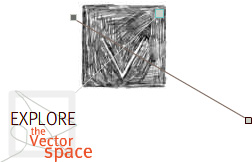Digital Dynamics Across Cultures
Design by Alessandro Ceglia
Author's Statement
This project grows out of my collaborations with Warumungu people in Tennant Creek, N.T. Australia over the last ten years. During this time, I worked with rotating groups of Warumungu men and women on a range of projects—all of which involved taking photographs and digital video recordings. Although the projects culminated in various "products," in every case, we were guided by a set of cultural protocols concerning the circulation, creation and reproduction of Warumungu knowledge and traditions. This meant, for instance, that some ritual songs we recorded could only be heard by women, or that some photographs could only be viewed by particular family groups, or that particular video footage of ancestral sites could not be viewed by the uninitiated.
At the most basic level this system operated within the logic of an "open"/"closed" binary. Some information is open, anyone has access. Other material is closed, only those with the proper knowledge have access. Yet the binary does not hold. Instead, there is a continuum between open and closed. Within this continuum various factors determine levels of access, gradations of control and multiple levels of engagement. These factors include (but are not limited to): gender, age, kin relations, country affiliations, and ritual knowledge. This is a dynamic system, then, that allows for the continual remaking and repackaging of Warumungu knowledge and tradition within various networks. And because Warumungu social networks include land ("country"), other-than-human relatives ("ancestors"), local kin groups ("mobs") as well as outsiders, the maintenance and creation of "proper"—but not static—traditional knowledge and cultural products involves constant negotiation. (For my article that develops this further see: Gone Digital)
Warumungu cultural protocols concerning authorship, ownership, viewing practices and knowledge creation are an intellectual property rights (IPR) system—a set of standards and limits for the use, redistribution, and reproduction of knowledge in its intangible (and tangible) forms. But the links between these Warumungu digital dynamics and the national and international legal systems in which they circulate are not stable. Legal regimes that demand a rigid public/private split and an author-centered notion of production deny Warumungu notions of property, access and circulation that are based neither on individual nor communal ownership. Instead, Warumungu groups base their distributional imaginary within dynamic relationships between small groups of people, related countries and ancestral relations.
This Vectors' site is designed to make Warumungu cultural protocols for the distribution, reproduction and creation of knowledge the primary logic. This is not a learning site—in the sense that users will come away knowing about "the Warumungu" in any complete sense. In the design concept we wanted to stay away from what I clumsily labeled a "video-game" feel. That is, we did not want to give users the "experience" of being (via an avatar-like persona) an Aboriginal person for a day. Nor did we want people to feel as if they could learn about Warumungu culture "whole cloth" through this site. This was not because of some lurking Luddite sensibilities or a knee-jerk Humanities reaction to "dumbing-down" the complexity of cross-cultural exchange. Instead, the site is deigned to alter the way in which "learning" about other cultures is perceived and presented.
By presenting "content" through a set of Warumungu cultural protocols that both limit and enhance (depending on who you are) the exchange, distribution and creation of knowledge, the site's internal logic challenges conventional Western notions of the "freedom" of information and knowledge "sharing" as well as legal demands for single-authored, "innovative," original works as the benchmark for intellectual property definitions. As users navigate through the site, they will encounter the protocols that limit, define and account for a dynamic and multiply-produced understanding of knowledge distribution and reproduction.



